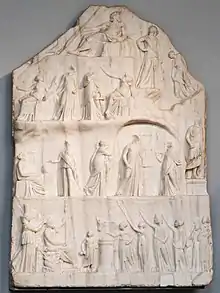The Apotheosis of Homer
The Apotheosis of Homer is a common scene in classical and neo-classical art, showing the poet Homer's apotheosis or elevation to divine status.

Homer was the subject of a number of formal hero cults in classical antiquity. The earliest notable portrayal of the scene is a 3rd-century BC marble relief by Archelaus of Priene, now in the British Museum.[1] It was found in Italy, probably in 1658,[2] but is thought to have been sculpted in Egypt. It shows Ptolemy IV and his wife and sister Arsinoe III standing beside a seated poet, flanked by figures from the Odyssey and Iliad, with the nine Muses standing above them and a procession of worshippers approaching an altar, believed to represent the Alexandrine Homereion. Apollo, the god of music and poetry, also appears, along with a female figure tentatively identified as Mnemosyne, the mother of the Muses. Zeus, the king of the gods, presides over the proceedings. The relief demonstrates vividly that the Greeks considered Homer not merely a great poet but the divinely-inspired reservoir of all literature.[3]
From the 19th and 20th centuries, treatments of the subject by Wedgewood (based on a 5th century BC vase misidentified in the 18th century as showing this scene), Ingres and Salvador Dalí survive.
A literary treatment of this subject was given by the German poet Leopold Schefer, 1858: Homer’s Apotheose, his last publication, itself a hexametric epos.
Notes
- A Companion to Greek Studies. CUP Archive. pp. 317–8.
- Lemprière, John; Lorenzo Da Ponte; John David Ogilby (1866). Bibliotheca classica. J.B. Lippincott & Co. p. 355.
- Morgan, Llewelyn, 1999. Patterns of Redemption in Virgil's Georgics (Cambridge: Cambridge University Press), p. 30.